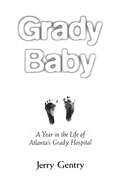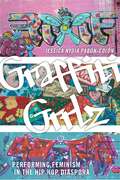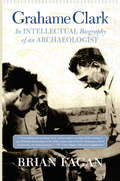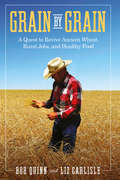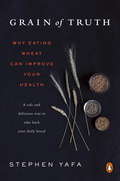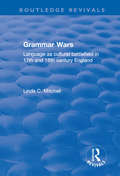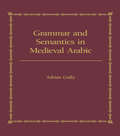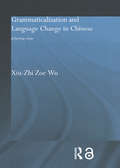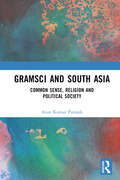- Table View
- List View
Grady Baby: A Year in the Life of Atlanta's Grady Hospital
by Jerry GentryGranted unprecedented behind-the-scenes access to the maternity ward of Atlanta's sprawling public hospital, Jerry Gentry binds together stories of women, medical residents, nurses, and midwives. In this teeming facility that never closes, he shows how their sorrows, struggles, and spiritual fortitude join at the moment when life begins. Gentry tells these stories in a style and pace that mirrors life in the hospital. Scenes may change rapidly or linger on the birth of a child or an older woman's struggle with addiction. Some individuals reappear throughout the narrative while some flash by and then are gone, leaving an indelible imprint on the memory. In his narrative, Gentry follows four principal stories: A young, single woman is having her second child. She gradually reveals that her relationship with her boyfriend is a violent one. An older woman—a “Grady Baby” and lifelong Grady patient—emerges as a kind of spiritual muse. In the charity hospital, a Brazilian émigré is pregnant by a man from a wealthy Atlanta family. A woman with AIDS faces the trials of a mixed-race relationship and the terrifying question—will my baby have the virus? Never maudlin, Grady Baby presents hard choices—some wise, some not—made by women enduring tough realities. The term “Grady Baby” has been traditionally a pejorative, stereotyping the race and class of patients, but it can also be a term of pride and strength. With an insider's eye and unflinching, humanizing narrative voice, Gentry reveals the battles, failures, and triumphs that occur in one year in the place where birth and the hardships of urban life collide.
Graffiti Grrlz: Performing Feminism in the Hip Hop Diaspora
by Jessica Nydia Pabón-ColónAn inside look at women graffiti artists around the worldSince the dawn of Hip Hop graffiti writing on the streets of Philadelphia and New York City in the late 1960s, writers have anonymously inscribed their tag names on trains, buildings, and bridges. Passersby are left to imagine who the author might be, and, despite the artists’ anonymity, graffiti subculture is seen as a “boys club,” where the presence of the graffiti girl is almost unimaginable. In Graffiti Grrlz, Jessica Nydia Pabón-Colón interrupts this stereotype and introduces us to the world of women graffiti artists.Drawing on the lives of over 100 women in 23 countries, Pabón-Colón argues that graffiti art is an unrecognized but crucial space for the performance of feminism. She demonstrates how it builds communities of artists, reconceptualizes the Hip Hop masculinity of these spaces, and rejects notions of “girl power.” Graffiti Grrlz also unpacks the digital side of Hip Hop graffiti subculture and considers how it widens the presence of the woman graffiti artist and broadens her networks, which leads to the formation of all-girl graffiti crews or the organization of all-girl painting sessions.A rich and engaging look at women artists in a male-dominated subculture, Graffiti Grrlz reconsiders the intersections of feminism, hip hop, and youth performance and establishes graffiti art as a game that anyone can play.
Grahame Clark: An Intellectual Biography Of An Archaeologist
by Brian FaganThe British archaeologist Grahame Clark was a seminal figure in European and world archaeology for more than half of the twentieth century, but, at the same time, one whose reputation has been outshone by other, more visible luminaries. His works were never aimed at a wide general public, nor did he become a television or radio personality. Clark was, above all, a scholar, whose contributions to world archaeology were enormous. He was also convinced that the study of prehistory was important for all humanity and spent his career saying so. For this, he was awarded the prestigious Erasmus Prize in 1990, an award only rarely given to archaeologists. This intellectual biography describes Clark's remarkable career and assesses his seminal contributions to archaeology. Clark became interested in archaeology while at school, studied the subject at Cambridge University, and completed a groundbreaking doctorate on the Mesolithic cultures of Britain in 1931. He followed this study with a magisterial survey, The Mesolithic Settlement of Northern Europe(1936), which established him as an international authority on the period. At the same time, he became interested in the interplay between changing ancient environment and ancient human societies. In a series of excavations and important papers, he developed environmental archaeology and the notion of ecological systems as a foundation of scientific, multidisciplinary archaeology, culminating in his world-famous excavations at Starr Carr, England, in 1949 and his Prehistoric Europe: The Economic Basis (1952). Clark became Disney Professor of Public Archaeology at Cambridge in 1952 and influenced an entire generation of undergraduates to become archaeologists in all parts of the world. He was also the author of the first book on a global human prehistory, World Prehistory (1961).
Grain by Grain: A Quest to Revive Ancient Wheat, Rural Jobs, and Healthy Food
by Bob Quinn Elizabeth Waterton Carlisle"A compelling agricultural story skillfully told; environmentalists will eat it up." - Kirkus Reviews When Bob Quinn was a kid, a stranger at a county fair gave him a few kernels of an unusual grain. Years later, it would become the centerpiece of his multimillion dollar heirloom grain company, Kamut International. How Bob went from being a true believer in better farming through chemistry to a leading proponent of organics is the unlikely story of Grain by Grain. Along the way, readers will learn how ancient wheat can lower inflammation, how regenerative agriculture can bring back rural jobs, and how combining time-tested farming practices with modern science can point the way for the future of food.
Grain of Truth
by Stephen YafaA Pollan-esque look at the truth about wheat: meal or menace? No topic in nutrition is more controversial than wheat. While mega-sellers like Grain Brain and Wheat Belly suggest that wheat may be the new asbestos, Stephen Yafa finds that it has been wrongly demonized. His revealing book sets the record straight, breaking down the botany of the wheat plant we've hijacked for our own use, the science of nutrition and digestion, the effects of mass production on our health, and questions about gluten and fiber-- all to point us towards a better, richer diet.Wheat may be the most important food in human history, reaching from ancient times to General Mills. Yafa tours commercial factories where the needs of mass production trump the primacy of nutrition, and reports on the artisan grain revolution. From a Woodstock-like Kneading Conference to nutrition labs to a boutique bakery and pasta maker's workshop in Brooklyn, he also finds that there may in fact be a perfect source of wheat-based nutrition. Its name is sourdough.For readers of Salt Sugar Fat and The Omnivore's Dilemma, Grain of Truth smoothly blends science, history, biology, economics, and nutrition to give us back our daily bread.
Grain of Truth: The Real Case For and Against Wheat and Gluten
by Stephen YafaA Pollan-esque look at the truth about wheat: meal or menace? No topic in nutrition is more controversial than wheat. While mega-sellers like Grain Brain and Wheat Belly suggest that wheat may be the new asbestos, Stephen Yafa finds that it has been wrongly demonized. His revealing book sets the record straight, breaking down the botany of the wheat plant we've hijacked for our own use, the science of nutrition and digestion, the effects of mass production on our health, and questions about gluten and fiber--all to point us toward a better, richer diet. Wheat may be the most important food in human history, reaching from ancient times to General Mills. Yafa tours commercial factories where the needs of mass production trump the primacy of nutrition, and reports on the artisan grain revolution. From a Woodstock-like Kneading Conference to nutrition labs to a boutique bakery and pasta maker's workshop in Brooklyn, he also finds that there may in fact be a perfect source of wheat-based nutrition. Its name is sourdough. For readers of Salt Sugar Fat and The Omnivore's Dilemma, Grain of Truth smoothly blends science, history, biology, economics, and nutrition to give us back our daily bread.From the Hardcover edition.
Gramin Arthashastra Second Semester FYBA New NEP Syllabus - RTMNU: ग्रामीण अर्थशास्त्र दुसरे सत्र एफ.वाय.बी.ए. नवीन एन.इ.पी. अभ्यासक्रम - राष्ट्रसंत तुकडोजी महाराज नागपूर विद्यापीठ
by Prof. Dr. Rakshit Madan Bagdeराष्ट्रसंत तुकडोजी महाराज नागपूर विद्यापीठाच्या (RTMNU) नवीन राष्ट्रीय शैक्षणिक धोरण (NEP) 2020 अंतर्गत प्रथम वर्ष बी.ए. (FYBA) अर्थशास्त्र अभ्यासक्रमात ग्रामीण अर्थशास्त्र हा महत्त्वाचा विषय समाविष्ट आहे. या पुस्तकात ग्रामीण अर्थव्यवस्थेच्या संकल्पना, शेतकी आणि बिगर-शेती क्षेत्रातील रोजगार, ग्रामीण वित्त व्यवस्था, सहकारी चळवळ, सरकारी धोरणे आणि ग्रामीण विकासाचे विविध पैलू सविस्तरपणे मांडले आहेत. ग्रामीण भागातील आर्थिक समस्या, त्या सोडवण्यासाठीचे उपाय, तसेच शेतीपूरक उद्योग आणि तंत्रज्ञानाचा विकास यावर विशेष भर देण्यात आला आहे. पुस्तकातील भाषा विद्यार्थी-अनुकूल असून, अभ्यासक्रमाशी सुसंगत उदाहरणे आणि तक्त्यांच्या मदतीने संकल्पना सुलभ करण्यात आल्या आहेत. यामुळे विद्यार्थ्यांना ग्रामीण अर्थव्यवस्थेचे आर्थिक महत्त्व अधिक चांगल्या प्रकारे समजते.
Grammar Wars: Language as Cultural Battlefield in 17th and 18th Century England (Routledge Revivals)
by Linda C MitchellThis title was first published in 2001: Although 17th- and 18th-century English language theorists claimed to be correcting errors in grammar and preserving the language from corruption, this new study demonstrates how grammar served as an important cultural battlefield where social issues were contested. Author Linda C. Mitchell situates early modern linguistic discussions, long thought to be of little interest, in their larger cultural and social setting to show the startling degree to which grammar affected, and was affected by, such factors as class and gender. In her examination of the controversies that surrounded the teaching and study of grammar in this period, Mitchell looks especially at changing definitions and standardization of "grammar", how and to whom it was taught, and how grammar marked the social position of marginal groups. Her comprehensive study of the contexts in which grammar was intended or thought to function is based on her analysis of the ancillary materials - prefaces, introductions, forewords, statements of intent, organization of materials, surrounding materials, and manifestos of pedagogy, philosophy, and social or political goals - of more than 300 grammar texts of the time. The book is intended as a landmark study of an important movement in the foundation of the modern world.
Grammar and Semantics in Medieval Arabic: The Study of Ibn-Hisham's 'Mughni I-Labib'
by Adrian GullyThe study focuses on a famous work by a mediaeval Arab grammarian who was once called the 'second Sibawayhi' (the pioneer of Arabic grammatical studies).
Grammaticalization and Language Change in Chinese: A formal view (Routledge Studies in Asian Linguistics)
by Xiu-Zhi Zoe WuThis innovative study on the phenomenon of 'grammaticalization' and its manifestation in Chinese provides new insights into language change in Chinese and a large number of grammatical topics. Grammaticalization occurs in all of the world's languages. Xiu-Zhi Zoe Wu demonstrates general linguistic principles present and active in the phenomenon of grammaticalization whilst also describing the modelling of language in formal theoretical approaches to syntax; so this book fills two major gaps in the current study of linguistics. Grammaticalization and Language Change in Chinese illuminates how studies of language development and change provide special insights into the understanding of current, synchronic systems of language. Using patters from Chinese, the author establishes cross-linguistic generalizations about language change and grammaticalization. This book should be of great interest to Chinese linguists and readers interested in language change in different languages.
Gramsci and South Asia: Common Sense, Religion and Political Society
by Arun Kumar PatnaikGramsci’s theory of common sense is a metanarrative that can be used to explain both religion and political formations. This book examines Gramsci’s perspective and how his theories translate into South Asian society. It explores Gramsci’s historicism, which is sensitive to historical, regional and national differences, and its relevance in post-colonial societies.The volume discusses themes like common sense, religious common sense, folk religion, dialogue and common sense concerning civil/political society through the lens of Gramsci’s historical perspectives. It also looks at Gramscian critique of political secularism, the ideology and politics of Hindutva, civil society in a non-Western context and modes of political society in India.Lucid and topical, this book is a must-read for scholars and researchers of political studies, political philosophy, post-colonial studies, South Asian politics, cultural studies and political sociology.
Gramsci's Common Sense: Inequality and Its Narratives
by Kate CrehanAcknowledged as one of the classics of twentieth-century Marxism, Antonio Gramsci's Prison Notebooks contains a rich and nuanced theorization of class that provides insights that extend far beyond economic inequality. In Gramsci's Common Sense Kate Crehan offers new ways to understand the many forms that structural inequality can take, including in regards to race, gender, sexual orientation, and religion. Presupposing no previous knowledge of Gramsci on the part of the reader, she introduces the Prison Notebooks and provides an overview of Gramsci's notions of subalternity, intellectuals, and common sense, putting them in relation to the work of thinkers such as Bourdieu, Arendt, Spivak, and Said. In the case studies of the Tea Party and Occupy Wall Street movements Crehan theorizes the complex relationships between the experience of inequality, exploitation, and oppression as well as the construction of political narratives. Gramsci's Common Sense is an accessible and concise introduction to a key Marxist thinker whose works illuminate the increasing inequality in the twenty-first century.
Gramsci: Space, Nature, Politics (Antipode Book Series #55)
by Michael EkersThis unique collection is the first to bring attention to Antonio Gramsci’s work within geographical debates. Presenting a substantially different reading to Gramsci scholarship, the collection forges a new approach within human geography, environmental studies and development theory. Offers the first sustained attempt to foreground Antonio Gramsci’s work within geographical debates Demonstrates how Gramsci articulates a rich spatial sensibility whilst developing a distinctive approach to geographical questions Presents a substantially different reading of Gramsci from dominant post-Marxist perspectives, as well as more recent anarchist and post-anarchist critiques Builds on the emergence of Gramsci scholarship in recent years, taking this forward through studies across multiple continents, and asking how his writings might engage with and animate political movements today Forges a new approach within human geography, environmental studies and development theory, building on Gramsci’s innovative philosophy of praxis
Grand Central Winter: Stories from the Street
by Lee StringerWhether Lee Stringer is describing "God's corner" as he calls 42nd Street, or his friend Suzy, a hooker and "past due tourist" whose infant child he sometimes babysits, whether he is recounting his experiences at Street News, where he began hawking the newspaper for a living wage, then wrote articles, and served for a time as muckraking senior editor, whether it is his adventures in New York's infamous Tombs jail, or performing community service, or sleeping in the tunnels below Grand Central Station by night and collecting cans by day, this is a book rich with small acts of kindness, humor and even heroism alongside the expected violence and desperation of life on the street. There is always room, Stringer writes, "amid the costume" jewel glitter...for one more diamond in the rough."Two events rise over Grand Central Winter like sentinels: Stringer's discovery of crack cocaine and his catching the writing bug. Between these two very different yet oddly similar activities, Lee's life unwound itself, during the 1980s, and took the shape of an odyssey, an epic struggle to find meaning and happiness in arid times. He eventually beat the first addiction with help from a treatment program. The second addiction, writing, has hold of him still.Among the many accomplishments of this book is that Stringer is able to convey something of the vitality and complexity of a down--and--out life. The reader walks away from it humming its melody, one that is more wise than despairing, less about the shame we feel when confronted with a picture of those less fortunate, and more about the joy we feel when we experience our shared humanity.
Grand Challenges of Our Aging Society: Workshop Summary
by National Research Council of the National AcademiesAging populations are generating both challenges and opportunities for societies around the globe. Increases in longevity and improvements in health raise many questions. What steps can be taken to optimize physical and cognitive health and productivity across the life span? How will older people finance their retirement and health care? What will be the macroeconomic implications of an aging population? How will communities be shaped by the shift in age structure? What global interconnections will affect how each society handles the aging of its population? To address these questions, the National Academies organized a symposium, summarized in the present volume, to determine how best to contribute to an evidence-based dialogue on population aging that will shape policies and programs. Presentations in the fields of biology, public health, medicine, informatics, macroeconomics, finance, urban planning, and engineering approached the challenges of aging from many different angles. The presenters reviewed the current state of knowledge in their respective fields, identifying areas of consensus and controversy and delineating the priority questions for further research and policy development.
Grand Designs: Consumer Markets and Home-Making
by Aneta Podkalicka Esther Milne Jenny KennedyThis is the first academic book to examine the long running hit series Grand Designs, which occupies a significant place in the popular imagination internationally. The authors apply an empirically grounded, critical perspective to the study of television to reveal how people use the program in their everyday lives. The emphasis on everyday uses and meanings combines creatively with understanding the program theoretically, textually and in terms of its production structures. This position challenges framings of the popular lifestyle and factual television genre that has been dominated by a neoliberal or governmentality perspective for many years. Presented by British designer and writer, Kevin McCloud, Grand Designs follows the progress of home owners as they embark on design, renovation and building projects at almost always dizzying scales of endeavour. Understanding the program as both a text to analyse and a site of material impact, the book draws on interviews with production members, home renovators, building practitioners and audiences, as well as references to associated media formats to provide contextual depth to the analysis. The authors argue that, as a cultural object, the program is both shaped by and enacts social discourses of home-making, design value and taste. Navigating public, commercial and promotional logics, Grand Designs sparks new forms of cultural production and consumer markets.
Grand Finales: The Creative Longevity of Women Artists
by Susan GubarOne of our most formidable literary critics explores how nine women artists flourished creatively in their final acts. In 2008, academic and scholar Susan Gubar was told by a trusted oncologist that she had only a few years left to live. Though she outlived that dire prognosis, this brush with mortality refocused her attention on the boons of a longevity she did not expect to experience. She began to think: In the last years of our lives, can we shape and change our creative capabilities? The resulting volume, Grand Finales, answers this question with a resounding yes. Despite the losses generally associated with aging, quite a few writers, painters, sculptors, musicians, and dancers have managed to extend and repurpose their creative energies. Gubar spotlights very creative old ladies: writers, painters, sculptors, musicians, and dancers from the past and in our times. Each of Grand Finales’ nine riveting chapters features women artists—George Eliot, Colette, Georgia O’Keeffe, Isak Dinesen, Marianne Moore, Louise Bourgeois, Mary Lou Williams, Gwendolyn Brooks, and Katherine Dunham—who transformed the last stage of existence into a rousing conclusion. Gubar draws on their late lives and works to suggest that seniority can become a time of reinvention and renewal. With pizzazz, bravado, and geezer machismo, she counters the discrediting of elderly women and clarifies the environments, relationships, activities, and attitudes that sponsor a creative old age.
Grand Island
by June Justice Crawford Gerald CarpenterWhen people think of Grand Island, they invariably picture the bridges connecting it with Buffalo to the south and Niagara Falls to the north. They might also think of it as a pleasant and conveniently located suburb or envision the island's natural beauty with the majestic Niagara River flowing serenely around it. But there were no bridges before 1935, and most people know little of the island's long, fascinating history up to that time. To the Iroquois, it was a valued hunting and fishing preserve; to British and French imperialists, a contested frontier asset. After American independence, it became whatever people could dream up--a tax-free utopian settlement, a refuge for Europe's persecuted Jews, a source of timber for Yankee clipper ships, a summer retreat for the wealthy, a playground for the masses, or a collection of small farm villages--all before it assumed its suburban form. Its colorful story, presented through this book's images, emerged from interactions between its unique geography and human imagination.
Grand Theater Urbanism: Chinese Cities in the 21st century
by Charlie Qiuli XueThis volume explores the phenomenon and trend of cultural buildings by investigating 10 typical cities in China from the first, second, and third tiers, and from the Chinese diaspora. Each grand theater design was the result of a high-profile international competition and created by global architects in collaboration with Chinese design institutes. The national and international significance of these iconic projects lies in the fact that they not only reflect the dynamics of global design ideas, but also represent a particular historical moment in China’s modernization process. The development, histories, and purposes of constructing cultural buildings are carefully outlined and colorfully presented. Given China’s tremendous population, the development trajectory of its urban construction will provide insights for other regions that hope to embark on the high-speed track in the 21st century.“In 'Grand Theater Urbanism', Professor Charlie Xue and his team document China’s current shift towards a culture of consumption and leisure, symbolized by the construction of multi-use Grand Theaters in major cities. 'Grand Theater Urbanism' reveals the unexpected variety and complexity of this contemporary cultural drive in a series of exemplary chapters with highly detailed, local, case studies.” --Professor David Grahame Shane, Columbia University, New York "Jane Jacobs likened city life to a performance. This book goes a stage further and analyses the actual performance spaces within cities in China. In doing so it makes a valuable connection between urban design and the cultural life in cities. This is an important and often forgotten dimension of urbanism and I heartily commend this book to readers.'" --Professor Matthew Carmona, The Bartlett, University College London
Grand Theft Childhood: The Surprising Truth About Violent Video Games and What Parents Can Do
by Lawrence Kutner Cheryl OlsonListening to pundits and politicians, you'd think that the relationship between violent video games and aggressive behavior in children is clear. Children who play violent video games are more likely to be socially isolated and have poor interpersonal skills. Violent games can trigger real-world violence. The best way to protect our kids is to keep them away from games such as Grand Theft Auto that are rated M for Mature. Right? Wrong. In fact, many parents are worried about the wrong things! In 2004, Lawrence Kutner, PhD, and Cheryl K. Olson, ScD, cofounders and directors of the Harvard Medical School Center for Mental Health and Media, began a $1.5 million federally funded study on the effects of video games. In contrast to previous research, their study focused on real children and families in real situations. What they found surprised, encouraged and sometimes disturbed them: their findings conform to the views of neither the alarmists nor the video game industry boosters. In Grand Theft Childhood: The Surprising Truth about Violent Video Games and What Parents Can Do, Kutner and Olson untangle the web of politics, marketing, advocacy and flawed or misconstrued studies that until now have shaped parents' concerns. Instead of offering a one-size-fits-all prescription, Grand Theft Childhood gives the information you need to decide how you want to handle this sensitive issue in your own family. You'll learn when -- and what kinds of -- video games can be harmful, when they can serve as important social or learning tools and how to create and enforce game-playing rules in your household. You'll find out what's really in the games your children play and when to worry about your children playing with strangers on the Internet. You'll understand how games are rated, how to make best use of ratings and the potentially important information that ratings don't provide. Grand Theft Childhood takes video games out of the political and media arenas, and puts parents back in control. It should be required reading for all families who use game consoles or computers. Almost all children today play video or computer games. Half of twelve-year-olds regularly play violent, Mature-rated games. And parents are worried... "I don't know if it's an addiction, but my son is just glued to it. It's the same with my daughter with her computer...and I can't be watching both of them all the time, to see if they're talking to strangers or if someone is getting killed in the other room on the PlayStation. It's just nerve-racking!" "I'm concerned that this game playing is just the kid and the TV screen...how is this going to affect his social skills?" "I'm not concerned about the violence; I'm concerned about the way they portray the violence. It's not accidental; it's intentional. They're just out to kill people in some of these games." What should we as parents, teachers and public policy makers be concerned about? The real risks are subtle and aren't just about gore or sex. Video games don't affect all children in the same way; some children are at significantly greater risk. (You may be surprised to learn which ones!) Grand Theft Childhood gives parents practical, research-based advice on ways to limit many of those risks. It also shows how video games -- even violent games -- can benefit children and families in unexpected ways. In this groundbreaking and timely book, Drs. Lawrence Kutner and Cheryl Olson cut through the myths and hysteria, and reveal the surprising truth about kids and violent games.
Grand Theories and Ideologies in the Social Sciences
by Howard J. WiardaThis book analyzes the main competing grand theories in the social sciences, including developmentalism, dependency analysis, Marxism, institutionalism, rational choice, Freudianism, environmentalism, sociobiology, neurosciences, and transitions to democracy.
Grand Theory in Folkloristics (Encounters: Explorations in Folklore and Ethnomusicology)
by Lee HaringEssays arguing diverse positions on the concept of a grand theory in American folklore.Why is there no “Grand Theory” in the study of folklore? Talcott Parsons (1902–1979) advocated “grand theory,” which put the analysis of social phenomena on a new track in the broadest possible terms. Not all sociologists or folklorists accept those broad terms; some still adhere to the empirical level. Through a forum sponsored by the American Folklore Society, the diverse answers to the question of such a theory arrived at substantial agreement: American folklorists have produced little “grand theory.” One speaker even found all the theory folklorists need in the history of philosophy. The two women in the forum (Noyes and Mills) spoke in defense of theory that is local, “apt,” suited to the audience, and “humble”; the men (Bauman and Fine) reached for something Parsons might have recognized. The essays in this collection, developed from the forum presentations, defend diverse positions, but they largely accept the longstanding concentration in American folkloristics on the quotidian and local.
Grandchildhood in Multigenerational Living: Practices, Meanings, Relations
by Adéla SouralováGrandchildhood in Multigenerational Living: Practices, Meanings, Relations is the first book to sociologically analyse grandchild-grandparent relationships from the perspective of grandchildren. Expanding the knowledge about hitherto under-researched grandchildren, this book puts grandchildren’s perspectives in the centre of qualitative analysis focuses. Presenting grandchildhood in its complexity, the author addresses its multiple dimensions from 54 in-depth interviews with grandchildren living in three-generation households with their parents and grandparents. Drawing upon 'family practices', this book conceptionally develops ‘grandchild practices’ as a new approach to see the diversities and similarities, harmonies and tensions, joys and obligations, or, simply put, the daily ambivalences of family relationships. This unique book is an indispensable resource for researchers and students of family studies and sociology of generations who wish to investigate how grandchildren understand, negotiate and make sense of their relationships with grandparents.
Grandes maricas de la historia
by Álvaro J. Sanjuán (@Otto_Mas)Nunca es tarde, amigos, para sacar del armario a un Gran Marica de la Historia Machos, heterosexuales, viriles... ¿Solo ese tipo de hombres han hecho historia? ¿Alguien puede creérselo? Más allá de la historiografía tradicional, nos encontramos con grandes poetas, intelectuales o cientí ficos homosexuales cuyos deseos han sido borrados. Es momento de sacarlos del armario. Desde Alejandro Magno o Leonardo da Vinci hasta Isaac Newton o Miguel de Cervantes, este libro desvela, de una manera desenfadada y a través de una profunda investigación, los grandes personajes homosexuales que han cambiado -pese a los prejuicios y las dificultades de su época- la historia de la humanidad.
Grandes misterios y leyendas de España
by José María ZavalaCon el rigor y la amenidad que caracterizan a José María Zavala, este libro responde las preguntas más famosas y controvertidas de la Historia de España. «En Grandes misterios y leyendas de España vibra de nuevo el historiador riguroso con alma de periodista.»Luis María Anson Tras escudriñar en archivos inexplorados, Zavala viaja por todas las épocas al rescate de episodios increíbles y arroja luz sobre asuntos como la identidad del «hombre de las mil caras», que se hacía pasar por primo del rey Alfonso XIII, los pormenores del círculo esotérico de Felipe II, el hombre que tenía rayos X en los ojos, el enigma de las apariciones de Garabandal, la maldición del teatro Eslava, el mismísimo conde Drácula español, la identidad del Leonardo da Vinci español, la autopsia del gran descubridor Cristóbal Colón o cómo murió en realidad el célebre torero Manolete.
